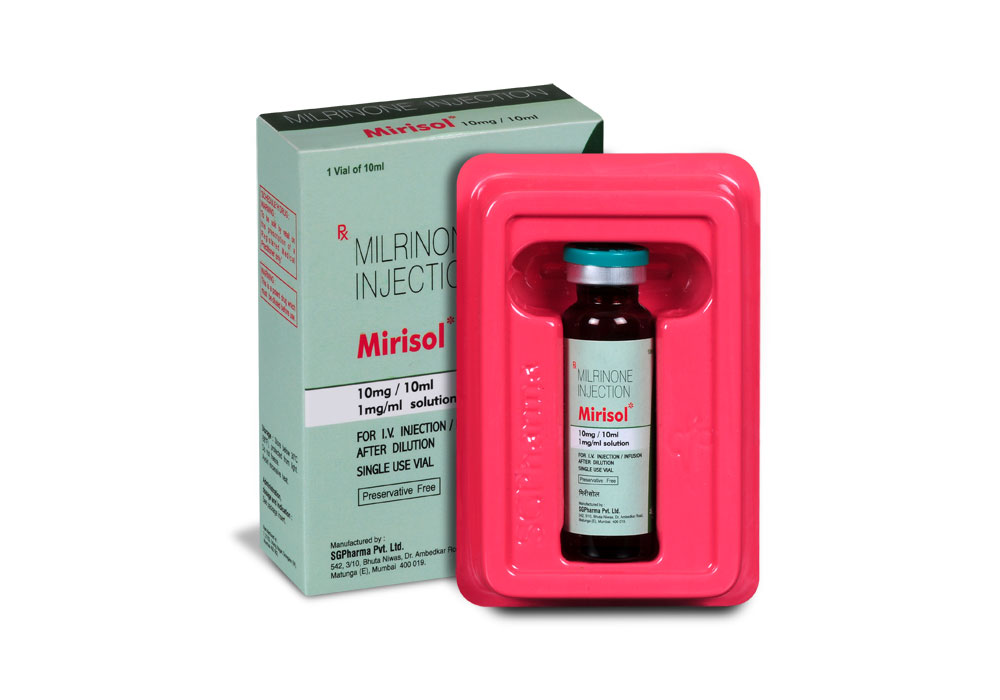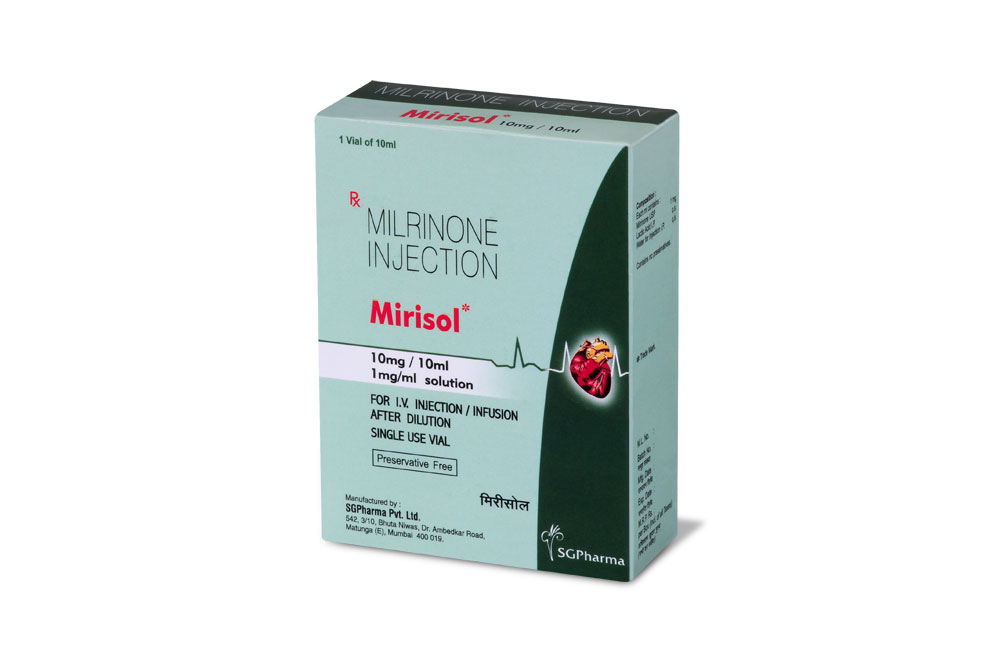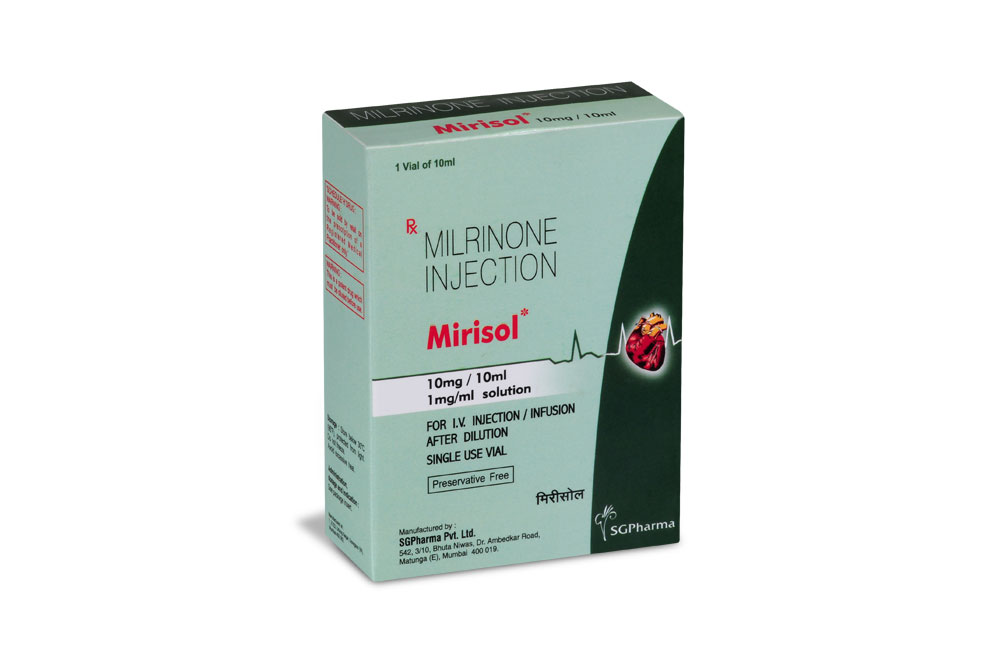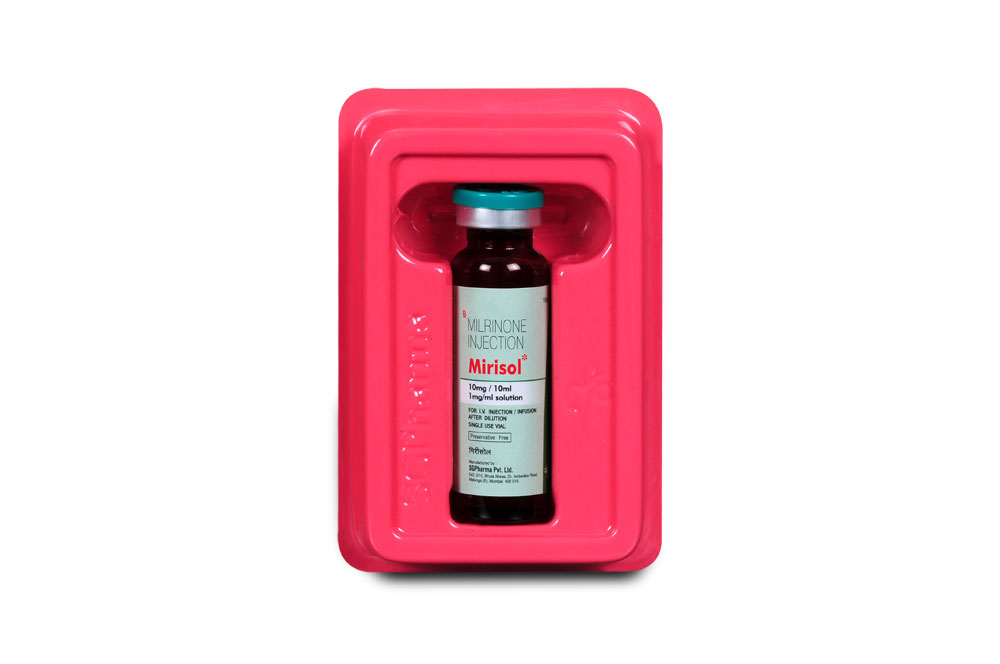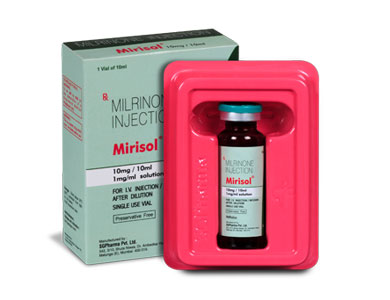
10 mg/10 ml
For the use of a Registered Medical Practitioner or a Hospital or a Institution only.
MIRISOL (Milrinone Lactate) is a member of a new class of bipyridine inotropic/vasodilator agents with phosphodiesterase activity, distinct from digitalis glycosides or catecholamines. Chemically, Milrinone is designated as 1,6-Dihydro-2-methyl-6-oxo [3,4’-bipyridine]-5-carbonitrile. Its molecular formula is C12H9N3O and its molecular weight is 211.2.
STRUCTURAL FORMULA :
Its structural formula is :
-Structure.jpg)
MIRISOL is a sterile, clear, colourless to pale yellow 10 ml solution filled in 20 ml Vial.
COMPOSITION :
Each ml contains :
Milrinone USP 1 mg
Lactic Acid I.P. q.s.
Water for Injections I.P. q.s.
Contains no preservatives.
MIRISOL should be administered with a loading dose followed by a continuous infusion (maintenance dose) according to the following guidelines :
LOADING DOSE
50 mcg/kg : Administer slowly over 10 minutes
The table below shows the loading dose in milliliters (ml) of Milrinone (1 mg/ml) by patient body weight(kg).
Loading Dose (ml) using 1 mg/ml Concentration
-Table-1.jpg)
The loading dose may be given undiluted, but diluting to a rounded total volume of 10 or 20 ml (see Maintenance Dose for diluents ) may simplify the visualization of the injection rate.
MAINTENANCE DOSE
-Table-2.jpg)
MIRISOL drawn from vials should be diluted prior to maintenance dose administration. The diluents that may be used are 0.45 % Sodium Chloride Injection, 0.9 % Sodium Chloride Injection or 5 % Dextrose Injection. The table below shows the volume of diluent in milliliters (ml) that must be used to achieve 200 mcg/ml concentration for infusion and the resultant total volumes.
-Table-3.jpg)
The infusion rate should be adjusted according to haemodynamic and clinical response. Patients should be closely monitored.
Note : See “Dosage Adjustment in Renally Impaired Patients.”
Dosage may be titrated to the maximum haemodynamic effect and should not exceed 1.13 mg/kg/day. Duration of therapy should depend upon patient responsiveness. The maintenance dose in ml/hr by patient body weight (kg) may be determined by reference to the following table.
MIRISOL Infusion Rate (ml/hr) using 200 mcg/ml Concentration
-Table-4.jpg)
When administering MIRISOL by continuous infusion, it is advisable to use a calibrated electronic infusion device.
Dosage Adjustment in Renally Impaired Patients
Data obtained from patients with severe renal impairment (creatinine clearance = 0 to 30 ml/min) but without congestive heart failure have demonstrated that the presence of renal impairment significantly increases the terminal elimination half-life of Milrinone. Reductions in infusion rate may be necessary in patients with renal impairment. For patients with clinical evidence of renal impairment, the recommended infusion rate can be obtained from the following table :
-Table-5.jpg)
CONTRAINDICATIONS :
MIRISOL Injection should not be used in patients with severe obstructive aortic or pulmonary valvular disease in lieu of surgical relief of the obstruction. Like other inotropic agents, MIRISOL may aggravate outflow tract obstruction in hypertrophic sub-aortic stenosis. Hypersensitivity to bipyridines or any other ingredient in the formulation.
WARNINGS :
Myocardial ischaemia or infarction may occur in patients following cardiac surgery. Should these events occur, care should be taken with the use of MIRISOL as information on the safety of MIRISOL under these circumstances is limited.
Use in Acute Myocardial Infarction :
Use of inotropic agents such as Milrinone during the acute phases of a myocardial infarction may lead to an undesirable increase in myocardial oxygen consumption (MVO2). Milrinone has not increased MVO2 in patients with chronic heart failure, however until further clinical experience with this class of drugs is gained, MIRISOL is not recommended during the acute phase of post myocardial infarction.
PRECAUTIONS :
Supraventricular and ventricular arrhythmias have been observed in the high-risk population treated. In some patients, MIRISOL has been shown to increase ventricular ectopy, including non-sustained ventricular tachycardia. The potential for arrhythmia, present in congestive heart failure itself, may be increased by many drugs or combinations of drugs. Patients receiving MIRISOL injection should be closely monitored during infusion. MIRISOL produces a slight shortening in A-V node conduction time, indicating a potential for an increased ventricular response rate in patients with atrial flutter/fibrillation which is not being controlled with digitalis therapy. In patients showing excessive decreases in blood pressure during therapy with Milrinone Lactate, the infusion should be stopped until resolved, then resumed at a lower rate if resumption is considered necessary. If prior vigorous diuretic therapy is suspected to have caused significant decreases in cardiac filling pressure, Milrinone Injection should be cautiously administered with monitoring of blood pressure, heart rate and clinical symptomatology.
Pregnancy : Category C
Although animal studies have not revealed evidence of drug-induced foetal damage or other deleterious effects on reproductive function, the safety of Milrinone in human pregnancy has not yet been established. It should be used during pregnancy only if the potential benefit justifies the potential risk to the foetus.
Lactation :
Caution should be exercised when MIRISOL Injection is administered to nursing women, since it is not known whether Milrinone is excreted in human milk.
Paediatric Use :
Safety and effectiveness in paediatric patients have not been established. Safety and effectiveness in paediatric patients have not been established.
Use in Elderly Patients :
There are no special dosage recommendations for the elderly patient. 90 % of all patients administered Milrinone in clinical studies were within the age range of 45 to 70 years, with a mean age of 61 years. Patients in all age groups demonstrated clinically and statistically significant responses. No age-related effects on the incidence of adverse reactions have been observed. Controlled pharmacokinetic studies have not disclosed any age related effects on the imination of Milrinone.
INTERACTIONS :
No untoward clinical manifestations have been observed in patients in whom Milrinone Injection was used concurrently with the following drugs: digitalis glycosides, lignocaine, quinidine, hydralazine, prazosin, isosorbide dinitrate, glyceryl trinitrate, Chlorthalidone, frusemide, hydrochlorothiazide, spironolactone, captopril, heparin, warfarin, diazepam, insulin and potassium supplements.
Chemical Interactions :
There is an immediate chemical interaction which is evidenced by the formation of a precipitate when frusemide is injected into an intravenous line of an infusion of Milrinone Injection. Therefore frusemide or bumetanide should not be administered in intravenous lines containing Milrinone Injection.
Effects on Laboratory Tests :
Fluid and electrolyte changes and renal function should be carefully monitored during MIRISOL therapy. Improvement in cardiac output with resultant diuresis may necessitate a reduction in the dose of diuretic. Potassium loss due to excessive diuresis may predispose digitalised patients to arrhythmias. Therefore, hypokalaemia should be corrected by potassium supplementation in advance of or during MIRISOL use.
SIDE EFFECTS :
Cardiovascular Effects :
Ventricular arrhythmias were reported in 12.1 % of patients receiving Milrinone Injection : Ventricular ectopic activity, 8.5 %; non-sustained ventricular tachycardia, 2.8 %; sustained ventricular tachycardia 1 % and ventricular fibrillation, 0.2 %. Holter recordings have demonstrated in some patients that injection of Milrinone Injection increases ventricular ectopy, including nonsustained ventricular tachycardia. Life-threatening arrhythmias are infrequent and when present have been associated with certain underlying factors such as pre-existing arrhythmias, metabolic abnormalities (e.g. hypokalaemia), abnormal digoxin levels and catheter insertion. Very rarely (< 0.01 %) cases of torsades de pointes have been reported. Supraventricular arrhythmias were reported in 3.8 % of the patients receiving Milrinone Injection. The incidence of both supraventricular and ventricular arrhythmias has not been related to the dose or plasma level of Milrinone. There is no evidence for a patient subset which is at higher risk for ventricular arrhythmias. Other cardiovascular adverse reactions include hypotension 2.9 % and angina/chest pain 1.2 %.
CNS Effects :
Headaches, mostly mild to moderate in severity, have been reported in 2.9 % of patients receiving Milrinone Injection.
Skin :
Dermatological reactions such as rashes have been observed in < 0.1 % of patients.
Other Effects :
Other adverse reactions reported, all with an incidence of less than 1 % but not definitely related to the administration of Milrinone Injection include hypokalaemia, tremor and thrombocytopenia. Very rarely (< 0.01 %) bronchospasm and anaphylactic shock have occurred.
OVERDOSAGES :
Overdose of intravenous MIRISOL may produce hypotension (because of its vasodilatory effect) and cardiac arrhythmia.
TREATMENT OF OVERDOSAGES :
If overdosages occurs, MIRISOL administration should be reduced or temporarily discontinued until the patient’s condition stabilises.No specific antidote is known, but general measures for circulatory support should be taken.
PHARMACEUTICAL PRECAUTIONS :
Parenteral drug products should be inspected visually for particulate matter and discoloration prior to administration, whenever solution and container permit.
STORAGE :
Store below 30°C (86°F), protected from light. Do not freeze.
Avoid excessive heat.
SHELF LIFE :
24 months from the date of manufacture.
PRESENTATION :
MIRISOL is supplied as 10 mg Milrinone in 10 ml aqueous solution. Single vial pack.

 Cardiovascular
Cardiovascular



